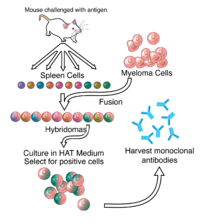
Photo from wikipedia
Inhibition of angiogenesis became clinical reality in 2004 with the approval of bevacizumab in metastatic colorectal cancer and we are now approaching the expiration dates of the patents for bevacizumab… Click to show full abstract
Inhibition of angiogenesis became clinical reality in 2004 with the approval of bevacizumab in metastatic colorectal cancer and we are now approaching the expiration dates of the patents for bevacizumab in the US in July 2019 and in Europe in January 2022. From the historical view on anti-angiogenic drug development, mainly targeting the vascular endothelial growth factor (VEGF) pathway, there were several ups and downs with the use of these agents, and the first euphoric view on the concept to starve tumors by blocking angiogenesis has many parallels with the enthusiasm we are facing at the moment with immune checkpoint inhibitors. As endothelial cells and not cancer cells are the main targets of anti-angiogenic drugs the scientific focus moved on the investigation and characterization of the tumor microenvironment (TME). These investigations led to the description of the complex and highly plastic TME, which finally led to the identification of new therapeutic concepts. Approved anti-angiogenic agents either neutralizing VEGF or blocking the VEGFR now form the backbone treatment of several cancer entities and will be used as combinational partners for new therapeutic strategies like immune checkpoint inhibitors or other new therapies in the future. In this special issue of MEMO, we are happy to offer the readers five articles written by experts in their respective fields presenting the current knowledge of anti-angiogenic therapies in different cancer entities and their future developments. We are glad to present two state-of-the-art reviews of role-model cancer entities for angiogenesis inhibition including colorectal cancer by Stragier et al. [1]
Journal Title: memo - Magazine of European Medical Oncology
Year Published: 2017
Link to full text (if available)
Share on Social Media: Sign Up to like & get
recommendations!